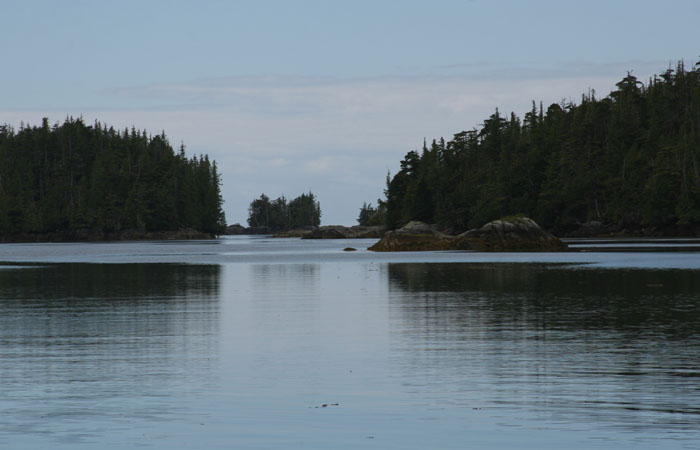|
|
|
Double click on small pictures to make them big
70 KNOT WINDS?!
“LAAAARRY, LARRY!!! 70 KNOT WINDS??? The dock guy said the weather said 70 knot winds!!!!” “Calm down, calm down, that can’t be right. Let’s get the boat tied up and we’ll see what’s going on.” How can there be 70 knot winds predicted?” I asked. “This is going to be a bad place at the dock. We’re exposed to the open harbor. Oh my gosh, 70 knot winds????” Larry is calm but I’m wondering to myself, “How can this be?” I knew the Front was following us but who said anything about 70 knot winds? I know what 50 plus knot winds feel like on a boat, on the water, and I don’t want to find out what 70 knot winds are like. I was really getting nervous and uptight. I could hardly concentrate on securing the boat to the dock. We put an extra line or two on, just to make sure, as the current was running a good clip.
FINALLY, after what seemed like a (FRIGGING) eternity, we walked up the dock to the dock office to see what the heck this weather report was that this kid was looking at. Larry told me he had checked the weather report earlier and there is nothing like that predicted so he doesn’t know what this kid is ranting on about. I’m thinking, well, sometimes these storms come up quickly and get a lot worse than predicted, and this is going to be one of them (always the gloom and doom attitude but I can’t help it). That’s why these waters can be so dangerous. I listened to several people along this journey northwards warning us about crossing the Hecate Strait, saying “those storms come up quick and fierce and can suddenly change from what the weather report predicts or those waters are shallow and treacherous when the seas build.” I, after hearing all these warnings and worrying about them, had created a monster filled with huge anticipation in my mind about crossing the Hecate Strait (which is our next leg). So, now here was proof I thought of what can happen in these waters. So here they are, the quick unpredictable conditions, and thank God we’re not out on that Strait! Well, we walked in to the office, Larry still calm. Larry asked to see the report first thing as he knew I was worried. Larry immediately says this says 50-70 km. I said “Well, what does that mean?” Larry said it’s not knots it’s kilometers. I say, “So???” He says, “That isn’t knots as YOU understand them, it relates to, at the most, only 42 knot winds.” “Not 70 knot winds?” the dock guy questioned. “No, its kilometers not knots”, Larry said again. “Oh”, he simply answered and then went about his work as if nothing had happened. OH? OH? This kid literally scared the bee-jill-lickers out of me. I’m wondering if this kid has any idea what he has just put me through. It was soon, very funny and an innocent mistake but whew!
A COUPLE ORANGE BALLS JUST IN CASE It’s not as rolly at the docks as I remember it from our first trip up here. The town has grown. I think more and more of the smaller cruise ships are finally making this a stop and it seems the town has grown and prospered from it. (Actually it seems all of Canada that we have seen has grown and prospered from 2002). There are lots of new tourist shops, more than I remember.
FISHING, FISHING, FISHING. Fishing, fishing,
fishing. I’m so sick of it. I’ve been reading and hearing too many
stories about the over fishing up here and well, we’ve seen it just about
everywhere so far but this is kind of like the last stand and the most
extreme. I could go on and on about salmon runs that are disappearing,
and endangered fish, but the fishing still goes on regardless. So why do
so many people bring in more catch than they could ever possibly eat in a
year? Why do they have to be so greedy?
I know it sounds crazy,
especially to those who don’t have an opportunity to be up here and see
what goes on. They may have no idea how serious the situation is and how
quickly our salmon fish population is declining and other fish too. I
think it’s because we just go to the fish market or super market or
restaurant and order up whatever our heart’s desire and we are served
promptly, and with a smile, but it’s sad but very true, we have a problem,
a big problem. It’s is horrible to see these beautiful creatures being
treated with such lack of concern and no forethought for their future.
IMAGINE THE FISH AS THE HUNTERS AND THE CATCH IS US They are so flagrant too with their slaughter, but more likely it’s just ignorance, a naivety about the health and survival of our fish and oceans. Nevertheless, no matter how innocent the act might be, the slaughter goes on and the over catch goes on. I can’t help but
just keep picturing in my mind this terribly morbid scenario, weird
and perhaps slightly sick but comparable perhaps. I keep wondering
what it would be like if the roles were reversed. What would it be
like if the fish were the hunters and the catch was US? What if
they caught us, and well, our whole family and that includes you and
your family? Can you picture them rolling you down the dock in the
dock cart, filled to the brim, well, not filled to the brim but over
the brim, with arms and legs hanging out. You’re only half stuffed
into those huge smelly coolers because there’s not enough room for
all of you and then when they arrive at the dreaded cold morgue like
metal cutting tables,
There it goes,
your whole family, in a Styrofoam box. It’s the whole dam gene poll
of your family, no hope for regeneration or survival or carrying on
of future generations. They are all gone in a flash of fleeting
idiocy. It doesn’t matter that you genes have been here and
evolving for hundreds of thousands of years. Nope, no more. Nah,
there’s no bringing you back, not even now after they have realized
their deadly deed. Then later in the day they look out their
windows and still see your decapitated head and maybe your cousin’s
too, well and the family clan, just empty heads with glassy eyes,
just bobbing by, oh and other body parts too, still floating even
though hours ago they were sliced up and discarded. Sadly you are
still not washed out with the ebb tide or even been lucky enough to
have been picked over by scavengers, maybe a raven or vulture, or
even as important as an eagle as all their stomachs are too full
with scraps of other humans, more than they could possibly ever
consume.
Wow, what terrible thoughts you say? I don’t think I would think these terrible thoughts if this fishing craze wasn’t so seriously effecting the survival of the salmon and other fish. I understand the fishermen needing to earn a living and I think many of them are as concerned as we are and others. But, what happens when it’s just plain all over? It’s simple, no job, no money, no way to continue on, and more importantly NO FISH! And what about the food chain? What happens when the fish are gone and all those that depend on the fish to survive? The birds, the bears, the decay that nourishes the forest? The fishermen are worried too, we’ve heard them talk. That’s why the fishermen we met in Dent were saving the eggs of the fish the out of towners caught. That’s why they raced them to the hatchery, their only last hope for the survival of the salmon in their waters. That’s why Bill Porter, a fisherman from Echo Bay, who’s lived and worked these waters his whole life, is trying tirelessly to restore the creeks and streams that once were full of fish and now nothing from over logging and fishing. I wouldn’t mind if we had lots to spare but we DON”T and each time I see gobs of them slaughtered like this and see the tens of 1000s of eggs just hosed downed the bloody drain and into the filthy harbor it makes me sick and enraged.
And what about “catch and release”? Well, we all know now that the survival rate on those is minimal. It doesn’t work. And what about fish farms? Don’t know about you but I’d much prefer to eat a real fish rather than some genetically altered, antibiotically fed, color dyed piece of flesh. What’s your vote? I don’t consider myself a crazy radical person, and I really do believe in the free enterprise system, and capitalism, but sadly, the more we see and learn from our travels on this beautiful ocean and along our magnificent shorelines, the more we realize what a sad story it’s becoming about the creatures that live in it and depend on it, and who only have us to save them. It’s sad to know that it is likely that they will soon no longer exist because of this kind of ignorance and disregard. I’ve just about had all I can take of it without saying a word of protest, so please forgive me for pointing out my concern that it soon will be too late. We need to take care of this ocean and its environment and those that live in it.
STORM IS HERE Well, the storm is finally here as it’s starting to rain. The barometer is 1008 now. We still see the crab boats crabbing their way around the harbor looking for a spot to squeeze into to ride the storm out I guess. The fishing boats come and go by us, grinding their bow thrusters, loudly yelling and rafting up to each other like one big family reunion. Every one is hunkered down now, fishermen, both small and large, both tattered and fierce, and the small and large “yachties” or cruisers, both tattered and slick. We’re all hovering together in unison, doing the same thing, waiting out the storm. As we were finishing
dinner on the boat, (it was one of those last dinners before
reprovisioning, the result of cleaning out the refrigerator and ending up
to be a strange mixture of just about everything), we see a guy go by on a
jet ski. Wait a minute! A jet ski?
JET SKIING ALL THE WAY FROM WASHINGTON!
When Larry came back he said, “He came all the way from Port Mc Neill (near the top of Vancouver Island, BC) ……...TODAY! That’s about 230 miles!!! He said he came up Greenville Channel doing 50 knots. He must have been flying.”
Wow, you really see and meet some characters up here. I finished up and hurried
down to talk with him. I asked if he was heading out tomorrow and he said
he’d have to see how the weather is doing. I guess with the speeds he
can go with that jet ski he could race most Front or storms. I told
Larry, “I bet he goes tomorrow.” He said he is going as far north as
Ketchikan and then will ship the jet ski back on the barge. I asked him
why he was doing this and he said he just wanted to see how the jet ski
performed. I asked if he sells them or manufactures them and he said “No,
I’m just curious.”
I’m amazed at the people we meet up here and what they do. Larry talked to another couple with two small kids in a small power boat that briefly docked behind us who said they were on their way to Glacier Bay, Alaska. They left Vancouver last Saturday. We wondered as we watched them leave the dock, “how are they doing it?” What about the storm? Off they went disappearing down the channel.
GILL NETTING OPENING Speaking of fishing, gill netting opened yesterday and several of the gill netting boats are here from Nanaimo and Vancouver. They travel from all over to get involved in the opening. We are overwhelmed as we see more and more of them come in to the harbor. CARVER FROM NOOTKA
SOUND We met an interesting guy at the local coffee shop that we like to go to everyday, who carves some wonderful Indian masks. They really are as good as any that I’ve seen around. We got to talking and he said that he was adopted by a family that lived in Friendly Cove on Nootka Sound, an Indian family, and that’s where he learned to carve. I don’t know if the story was a crock but I don’t think so because he seemed to know so much and his work seemed so representative of the native style. We talked to him for a long while and listened to him relate the history of Nootka Sound and some of the stories his family told him about the Indians there. It spurred a real interest in us to go there. We are planning to come down the West side of Vancouver Island so he told us we must stop there. Surely we must. We woke up at 6:30 AM the next day as one of the boats in front of us started their generator and we had our windows open and soon our bedroom filled with exhaust. I hate that. Why the heck is someone running their dam generator at the dock again? Barometer is 1004, not changing much. STORM HAS PASSED AND
ALL IS STRANGELY DEAD CALM We looked around the docks this morning. It’s the quietest I’ve ever seen this place (which is always bustling) and its 7:30 in the morning. There are no winds and no boats out. Every one has been hunkered down because of the storm. We listened to the weather report and the storm has past now. There are no more gale warnings. Guess it was all fluff and no stuff but no one is venturing out at all. That storm turned out to be a flop, but regardless we all hunkered down in preparation for it. About 8:00 AM we see one cruiser heading out into the grey flatness, all alone. They are probably heading south we think. Most everyone, the few pleasure cruisers that are here, are heading south now, well except for that crazy jet skier, he’s headed north but at 50 knots, he can head north if he wants. He too decided to lay low for a day to let the storm go by, but I watched as he headed out today, all alone, no one to give him a send off on his magnificent adventure. The fog has crept in without any notice like an unwelcome guest. We are surprised at the number of Canadian boats up here with no names on the back or hailing ports. We know they are Canadian as they are flying Canadian flags. I’ve never seen that anywhere. Isn’t that illegal? How could you hail them or report an emergency for them without a name to reference to? Don’t understand the lax rules up here. BUSH PILOTS We see a float plane flying off low underneath the layer of thick fog. He can only count on whatever visibility he can find underneath the thick layer of cloud cover to make his journey today. As long as he flies low he can see but if the layer lowers, he’s taking his chances and will be forced to land on water I guess. We are always amazed to see these guys fly in conditions that others wouldn’t. They hover low to the water and follow the water ways just like a boat. These bush pilots up here are something else. We never fail to be amazed at them.
There’s a huge tide up
here. We had a 22 foot tide this week. If you can imagine the adjustable
ramp from the docks to the yacht club as it goes up and down during the
changing of the tides. You plan your work in more ways than one by the
tide. You certainly don’t want to be pushing heavily laden carts up and
down the ramp when it is almost in a vertical position so you wait for
high tide when it is almost flat, that’s when you get the groceries. It
makes your work much easier. On the other hand we noticed a fishing boat
that managed to meander his way in right up to the top of the ramp next to
the yacht club and tie up to some blocks. This is an amazing stunt as at
low tide it’s a shear hill, all mud exposed tidal plain. We were shocked
to see when the tide went down that his boat didn’t. Soon it was
completely out of the water, nicely positioned on some blocks that had
been there concealed under the water. The bottom of his boat was
completely exposed now and out of the water and he began immediately,
wasting no time, scraping and cleaning the bottom of the boat, preparing
for paint which he would do the next day or next tidal cycle during day
light hours when the tide went out again. This went on for two days as we
watched him come and go working on his boat and then one even t’s a changing landscape here, as everything coordinates around the tide. When it is low, the scenery is completely different. At low tide our surroundings become on big mud flat all around us and you are amazed at how shallow some places are and wonder how some boats know exactly the dredged out paths like the back of their hand as they are clearly exposed when the extra low tide goes out. All the dinghies and skiffs and some of the small boats who only require shallow depths, are completely sitting on the mud during this neap tide which means extra low and extra high tide. Also, the mud exposes all kinds of goodies for the eagles and ravens and other birds and wild life to eat. It’s like Mother Natures free buffet each time the tide goes out and they sure know it like clock work. They are a bunch of free loaders at hart and don’t miss a skip or tide I should say. It’s like the most popular restaurant in town. Of course, many of the discarded fish heads and carcasses are exposed on the mud too and that creates for a lot of squawking and fighting between them all, fighting for any morsels that they can steal from each other sometimes in mid flight which can be exciting to watch. Of course these extreme
tides create some havoc in the marina. We saw many near misses as a
result of the strong currents created by these tides. Everyone has
fenders on their boats, not to protect themselves against the docks but to
protect themselves from other boaters not used to handling their boats in
these conditions. We can say we saw a few hits on boats with no owners in
them. No serious damage though as everyone has themselves pretty well
bumpered, both the guy at dock and the one coming in. AYE MATEY, ROWING ALL THE WAY FROM WASHINGTON One day I watched as six
young people rowed in on a wooden “exploration ketch”, called TERN. It
couldn’t have been much more than 20 feet or so in length. It was a
dreary day, with all the wetness, rain and bitter cold dampness that a day
like that serves you and you didn’t expect to see someone out in an open
boat, exposing themselves to it. These young people were dressed in
bright yellow foul weather bibs and woolen sweaters and caps and looked
like something that had just come in from the fog off the Maine coast in
the 1700s or 1800s. When I got a closer look at them, they were worn and
tired and had several weeks’ worth of growth as evidenced by some pretty
salty looking beards and knarled hair. They were several weeks beyond the
respectable hair cut schedule. Their faces and checks were flushed from
their exposure to the elements and they were thin and drawn from their
journey and most of all just plain exhausted. One of the crew members got
off the boat and went up the dock and the rest sat in their ketch, holding
on to the dock with their hands and just satisfied to sit and rest. They
didn’t get out. They looked like they were stopping only for a few
moments at the dock. I just had to find out about them. I got out of the
boat and walked down the dock to ask where they had rowed from and one
tired lad answered back with a very expressionless look on his face,
“Washington.” I had to ask again. “Did you say Washington?” “Yes, from
Lopez Island.” I was amazed, as again, like the jet skier, that was about
250 or so miles away. The only difference was their mode of travel
was the old fashioned man powered kind, exposed to the elements in all
ways exactly like the exploration crew of the ship Discovery captioned by
Captain George Vancouver himself back in the 1790s. They didn’t offer
that parallel but that’s immediately what came to my mind and as you
travel these waters it’s what every boater thinks about, the courage and
diligence of the captain and crew of the Discovery as they in the same
manner explored the inlets and shorelines of these treacherous lonely
waters in boats, ketches, almost identical. These kids were experiencing
first hand perhaps what it truly must have been like back in the late
1700’s though they didn’t have the burden of exploring each and every
inlet, charting, recording, and looking for the Northwest Passage. These
kids had a more direct route. There was no going in and out every inlet
looking for a new undiscovered passage. They also had luxury and help of
paper charts, not surprisingly with the same charted information that
Vancouver had originally provided for all of us. That information
provided us with charts, making it possible for all of us to explore these
waters but now we also have the additional help of updated NOAA charts,
electronic charts, GP, radar, VHF radios and satellite phones. Most of us
have no comprehension of their monumental task. These kids may have a
glimmer of what it must have been like though as they have no covered
protected cabins, beds, toilets, galleys, refrigeration, or heat, only the
additional help of two small masts and sails, and what I imagined a good
stash of prepackaged trail mix, beef jerky, a few chocolate bars and
whatever they managed to fish or catch along the way to cook over the open
campfire. Everything else was open to the elements, and powered by muscle
power. AMAZING, truly amazing!
I went to tell Larry about these amazing young people and what they are doing and before you know it, they were off again, slowly and methodically rowing down the harbor, perhaps to the public docks (as Prince Rupert Yacht Club was turning people away in a steady stream as “they were full” with empty spaces reserved for people that many times never showed up). Even these kids might have been turned away but I’m sure they found a place somewhere to rest for the night. They said they were very tired and their original plans were to get to Alaska but they weren’t sure at this point if they were going to continue on. They said they would decide tonight whether to continue on but for sure they would go only as far as Ketchikan. Only go as far? I think they have done an amazing job already. What an undertaking.
What the heck is going on here at PRYC (Prince Rupert Yacht Club)? They have been turning away boaters the whole week and there has been plenty of space. We felt really sorry for two boats that had just crossed Dixon entrance from Ketchikan (a long stressful day in anybody’s book). They turned them away even though they had plenty of free dock space because they “had reservations”. The two cruisers then asked if they could just dock long enough to check in with customs but they wouldn’t even allow that. Then we noticed that night that the empty spaces never filled. We had learned in 2002 from our traveling companion MV Patience that you need to call ahead if you can and make reservations or you are taking your chances on getting space here. Guess it’s even more true now with more boaters up here. The problem that we saw here was also the same in Shearwater. There are a lot of boats that are just left here while the owners have the luxury of flying home and back. Also, a lot of space is being taken up by sports fishing enterprises. Space for cruisers like us is getting less and less available. If you don’t have the luxury of a satellite phone to call ahead for reservations, you’re probably out of luck. I thought those satellite phones were for emergencies only, now they are for making reservations. What ever happened to getting away from all that? Isn’t that why we come up here to get away from all that kind of hassle?
We saw several cruising boats that couldn’t get dock space and were just too tired to go on, anchored across the channel, not a very nice place to be. We heard from a lot of cruisers later telling of being turned away because of no space. Some said they are just skipping Prince Rupert all together now because of it. The frustrating thing was seeing people turned away and then the dock space remained empty. It seems like they are saving a lot of space for people that don’t show up. Gill Net OPENING Some cruisers who couldn’t get in at PRYC were just going over to the docks normally used by the fishing fleet and had no power. That became impossible though when Gill Netters opened because then the place was filled with commercial fishing boats. Fishing boats were coming in by the hundreds. I’ve never seen anything like it. It looked like there were three fish buying boats anchored right out in the channel just across from the fish processing plant. Fishing boats were coming and going all day long, heading straight to the fish buying boats, rafting up, unloading their catch, and then going straight out again to fish more. The traffic was chaotic and I could honestly say quite on the same level as LA during work traffic. These guys work nonstop and don’t stop until the last absolute bit of light has gone, (which up here can be late) and then they finally begin to come in to the nearby docks to rest or find a place to anchor or raft up. They quickly take over the fishing docks like a bad disease, rafting to each other as thick as mud and if they aren’t able to find anymore room there, they anchor across the channel in droves; many rafted three and four together. I’ve never seen so many fishing boats in one place. How could a fish possibly escape or survive the odds of all this?
The weather is rainy and cold. Day after day it’s been dreary and overcast with nonstop drizzle. Again we walk the docks waiting for the weather to clear and the high to come in so we can make our crossing. The weather is depressing and doesn’t help with my anticipation of crossing Hecate Strait soon. We watch the gobs of people coming in everyday from a day of sports fishing. It goes on, day in and day out; sometimes it’s the same couples, who have flown in from the states or wherever. Each day, at the end of the day, they bring in their day’s tuck load of caught salmon and every once in awhile a small halibut not even having a chance to get fully grown. Why do two people need that much fish? They pride themselves in their catch and have such joy carving them up, piles of them on those metal gurneys. They cart them out, carts and carts, barely able to push them up the ramp in disgusting blood dripping plastic cartons. I guess it’s just something in their blood up here, this uncontrollable urge to fish. ANOTHER WARNING ABOUT HECATE STRAIT We just watched amazed at the non stop activity and parade of the fishing boats. They just keep coming and going. It’s much like Hong Kong Harbor, busy and crowded.
Three Canadian Naval ships came in and docked at the ferry dock.
A large
converted commercial fishing boat came in and finally took up a large
space on the dock that had been empty for days. He had three or four
aluminum fishing skiffs off the back. He’s like a floating fishing lodge
with bunks, and galley and this captain, part Haida, can take a sports
fishing group to where the fish are with sturdy fishing vessel.
(Rain, Rain, Go Away Come Again another day) Larry has been watching the weather everyday. He’s been saying that tomorrow will be the day. He’s predicted this day for a week and it looks like it’s time to go.
We awoke at 4:30 AM as one fishing boat after another is leaving for the fishing grounds. They were creating wakes all through the channel and woke us up. I guess when they have an opening they work like mad using every possible spec of daylight no matter how long hard and how tiring the work is, they use every ounce of light and available time. The parade of fishing boats continued for an hour or more as they headed out and disappeared into the darkness only their red and green running lights fading into the darkness like millions of fire flies. As they left the over crowded docks became eerily empty. We finally went back to bed and tried to get a little bit more sleep. As I dosed off I wondered if there would be any fish left in the ocean after this madness. If there were I’d be surprised. I’M REALLY SCARED We are leaving today for our anchorage and then if all still looks promising, will head across the dreaded Queen Charlotte tomorrow. I’m very nervous about it though the conditions couldn’t look better. I am just guilty again of having read too much stuff about it. I know better than that but I did it again. I read that it’s “the fourth most dangerous body of water on earth.” I read about people having started across, getting almost half way and having to turn back as conditions suddenly turned for the worse without warning. I read the dangers of coming into Sandspit as the current can get rough there and shallow causing waters that heave up and swallow a boat giving it the name grave yard for boats. I’ve read how shallow Hecate Strait is and how the sea can get very rough on those shallow water and how the weather can change instantly and get bad, turning to dangerous, and how many lives and boats have been lost, etc. etc. etc. and more etc.
Then I read how the Haida people were master canoe builders and seamen. I read how they took their sturdy canoes, open craft, across this dangerous body of water. They were fierce and powerful and all along the Pacific Northwest Coast they were feared. The sight of them appearing from stormy seas of Hecate Strait was a sight to behold they said. They had no fear of risking their lives in an open canoe on this ocean. They were feared all the way south as far as Puget Sound and they liked to raid the coastal villages taking slaves from other native people. That gave me encouragement. We don’t have far to go today. We’ll be going to our anchorage that will give us a good starting point to cross Hecate the following morning. We’ve begun buttoning things up on the boat and stowing items that might get thrown in bad seas. The weather report is favorable but I still can’t help putting things away and preparing for the worst. I told Larry I don’t want to take Knotty Dog off the dock today because of the strong current. We’ve had 22 foot tides and they can create a strong current and depending on which way it’s going, can make for a difficult time. TIME TO GO We leave the dock and head down the channel past Prince Rupert. As we are passing the waterfront of Prince Rupert, we hear a woman on the radio, Channel 16. She is reading off a monotonous list of numbers. We have no idea why nor what it means. We noticed it when we came in a few days ago. It’s mind numbing and strange and makes you feel like you are in outer space. It just goes on and on and we wonder why or how she can be doing that on 16. She must be calling off the fishing boat numbers as most don’t even have names on the boats, just big hand painted numbers. The morning sun is breaking through and it seems more positive out now. The constant overcast and drizzle has been very depressing and you find yourself getting wrapped up in its dreariness. I don’t know how people live up here, day after day, not seeing the sun and this constant never ending wet rain and that’s summer. Then all they have to look forward to in the winter is freezing cold and no light. Although the weather can be so depressing we’ve surprisingly found the town’s people to be extremely nice and cheerful, always ready to greet you on the street with a big smile and a warm friendly “hello”. I remember that from our last visit here. We are now heading back the same course we came in except going the opposite direction. We still are missing that chart, the missing link. We see M/V Giraffe ahead; she’s a 62 Nordhavn with a hailing port of Vancouver. Larry had talked to them the day before. They said they were heading south like everyone else it seems. There’s something strange about heading off in a direction different than everyone else. But that’s what we are doing as we head West. He looks like he’s going out another passage south more on the outside. We’re wondering where he’s headed. Maybe he’s going on the outside (mean on the Pacific exposed side). The water in the harbor was terrible this morning. I think it was from the fish processing plant right near the marina. It was filled with the most terrible muck, probably ground up fish waste, and that, mixed in with the usual sewage, it was awful. It smelled all night too. They have no respect for their waters up here. Sadly they just dump any old thing into it. WHERE ARE ALL THE FISHING BOATS? The harbor was so quiet this morning as the fishing boats are all out someplace. I wish I knew where. As we head out past the wheat loading plant, we suddenly see where they are. Many of the big fishing boats are heading back in to the channel to Prince Rupert but in the distance, in front of us, are all those gill netters that left this morning at 4:30 AM, hundreds of them. They are surrounding the entrance to the great Skeena River letting out nets and pulling them in catching any salmon that is trying to get up the river to lay its eggs. It’s crystal clear now where Giraffe is going. He’s trying to go around the fence of booby traps created by the Gill Netters. It looks like an army out here. There is an amazing long line of boats with their nets all let out.
Watch out for the logs too! Oops, just missed that one. Oh, now it starts to rain too. What next? Oh, look a poor fish jumped up out of the water, poor thing. Wonder if he’ll be able to get past the nets and up the river to its breading grounds. He’d be one lucky bastard if he did, I think. OK, let’s concentrate on getting through this mess. OK, look for the red balls; they have lines tied between them and the back of each boat. On the line are small white floats, hard to see as they are very small, lie low to the water and the wavelets hide them. “Oh no, Larry, the fog is coming in. How are we going to do this?” Hey, mix this all in with a couple crazy kayakers up here. This is the ultimate test. Just think, we could be home, at the bakery, sipping on a coffee, eating a fresh roll and reading the morning paper. What the heck are we doing here? Testing our skills to the limit I guess. Why? Red balls, lines, logs, red balls, lines….. “Okay, Okay, I see the end of that one Larry, go port to that red ball then cut starboard to the other ball. The lines are in between the two.” This went on for hours. It was tense and exhausting. Once you get the boats figured out it’s not so bad. You know each one has a long line out the back or stern, with little white floats on them and at the end of the line is the big orange red float ball that you can see easily. So best thing is to spot the boat and look for his orange float and then try to fine the line with the white floats and track it back to his boat. Then you know what way to pass him. Or you see an orange float and try to track that back to which boat it belongs to. Sometimes it was difficult because there were so many balls and so many boats. You didn’t know which went with which boat. The only thing you can do is weave your way in and around this maze of boats and nets, and floats. Some boats are curling around to pick up the orange float and reel the nets back in, so you’ve got to watch what the boat is doing to and anticipate his maneuvers and how he’s drawing the net in. Other boats are traveling fast to let the line out. Some are sitting and waiting I guess for the right time to then pull the line in and get their catch. We would find small openings and just began our path weaving across them not forgetting to watch out for submerged rocks and logs and dead heads. Sometimes we would have to get way off course to avoid them and then had to make sure we were also watching the charts and rocks and not just solely these giving all our attention to the boats. The Coast Guard said the
opening started at 8:00 AM and ran to 22:00. Larry had hailed the Coast
Guard and asked the protocol and she said just call the fishermen and
ask. That’s crazy how could we do that? They don’t even have names on
the boats, half of them. Larry asked what channel they monitored and she
said 68 or 78. We turned those stations on to monitor those channels to
at least listen in case one of them hailed us and that’s when we heard
what sounded like Chinese or Taiwanese, like the first time we came to
Prince Rupert when the place was filled with crab boats and they all
seemed to be speaking some Asian language. This is crazy. WHAT A NIGHTMARE What a stressful couple hours. Giraffe had tried to go around them but we just decided to work our way through. By the time we got through, we had caught up with Giraffe just coming back on course again. I don’t think they were able to avoid them even though they went way around because there were so many boats they were like locusts devouring the sea for as far as you could see. We finally breathed a sigh of relief as we headed down Ogdon Channel leaving the Gill Netters behind us. Giraffe headed off down Greenville Channel. The day was not only stressful but weird as there is a mixture of every kind of condition you could imagine going on all at once. There was a mix of clouds, fog, rain, sun, blue skies, grey skies and at some point the water sparkled like diamonds concealing any hopes of trying to spot those dam floats. GILL NETTERS BEHIND US AND NOW ON A PATH LESS TRAVELED We’re heading out a path less traveled now, heading out towards Hecate Strait. I look back as Giraffe and other boats are heading down the well traveled path of Greenville Channel. Hopefully there will be some company in our anchorage. Maybe there will be another boat with the same dream of visiting the Queen Charlottes and testing their limits too. Maybe we’ll luck out and have a buddy boat to at least talk with occasionally on the radio tomorrow during the crossing. We could compare conditions or just see how each other is doing. It would be so comforting.
The sun has gone to visit someone else and left rain and grayness again. It’s beautiful though nevertheless. We see beautiful silhouettes of many small rocky bonsai like islands with top hats of trees. Suddenly and unexpectedly, through a break in the grey silhouette of islands we see Kitkatla Indian Village. Just when you think you are alone in the midst of dreary thoughts and no civilization you see a warm vision. It was a surprisingly good sized village and very picturesque nestled in amongst these little islets. We continue on wishing we could’ve stopped to see more. The water is very calm in this protected area of small islands even though we are getting very close to the large body of water of Hecate Strait. We have had 22 knot winds most of the day which makes me nervous because that is not what was predicted but as we get closer to the anchorage, the winds die down to about 9 knots, more within the predicted weather forecast.
We drop the anchor and settle in, alone. I kayak to shore with Ziggy and see an otter peeking out from a rock, like checking out to see “who’s new in the neighborhood?” He soon gets bored and goes back to his business, whatever he was doing in that rock pile. It’s a beautiful anchorage and we find several streams pouring out over large rocks into the anchorage. The sounds of water falls and streams in the forest created strange sounds like people talking and whispering. Are there people in the forest? Maybe they are from the nearby Indian village or is it just the sounds of the forest? We see a family of eagles that soar over our heads to check us out. There are several fish jumping completely out of the water in the anchorage. Hope they stay here for awhile until the fishing period has closed. I’m tired and stressed
about this next journey. The anticipation and fear of it is pushing my
limits. This is certainly testing my fears and my courage. It will
challenge my strengths and faith and trust in Larry and myself that we can
do this together. I know it sounds dramatic and ridiculous but there are
different levels of fear for everyone and this is a big one for me.
Larry seems quiet and confident. I’m quiet too but not so confident.
I keep thinking about that Haida captain. Even he, a brave Haida, said it can get rough out there. He warned us to be careful. I keep having flash backs of when I told him the weather report for the crossing and asked what he thought. I can see him clearly as he looked off in the direction of Queen Charlotte and then he glanced at our boat for a moment, considering and then said “it should be OK.”
|
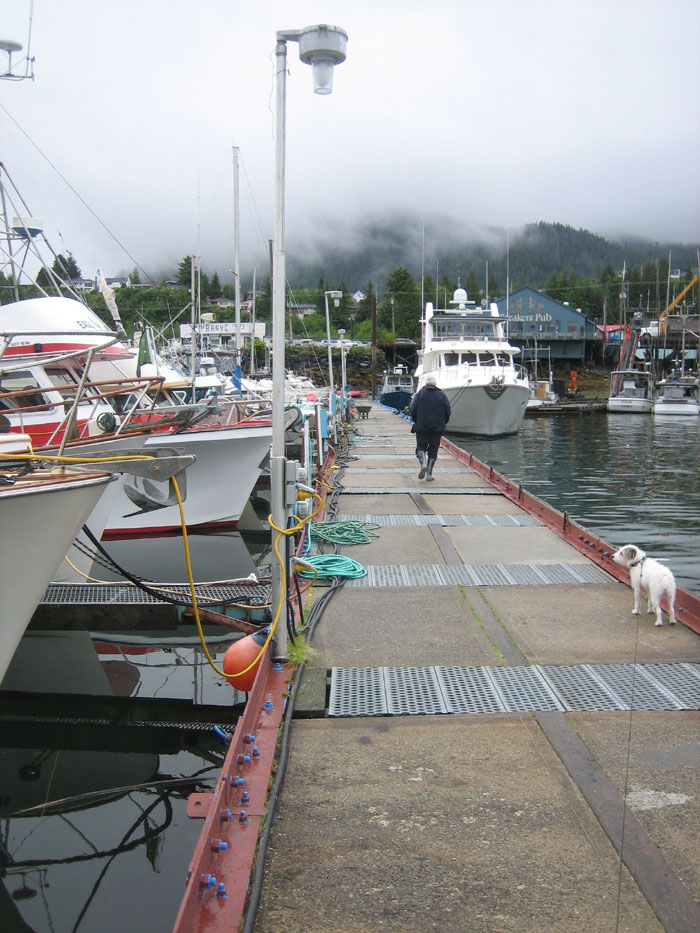
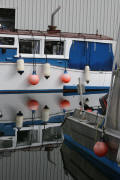







































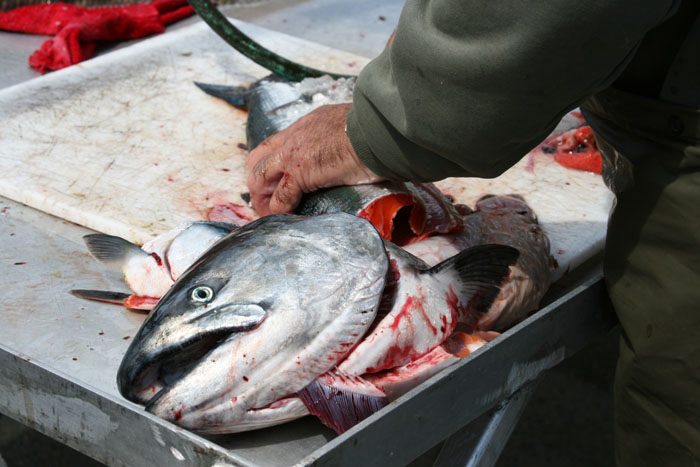 I’m beginning to hate walking by
those fish cutting stands as we walk down the dock to go to shore. They
look like big cold metal gurneys, like what you’d imagine in a morgue with
a dead cold stiff laying on it and what about the way they so casually
decapitate these beautiful fish and throw their magnificent heads over the
side into the water along with their guts and bones, and fins? It just
seems so demoralizing for such a beautiful species that is severely on the
brink extinction.
I’m beginning to hate walking by
those fish cutting stands as we walk down the dock to go to shore. They
look like big cold metal gurneys, like what you’d imagine in a morgue with
a dead cold stiff laying on it and what about the way they so casually
decapitate these beautiful fish and throw their magnificent heads over the
side into the water along with their guts and bones, and fins? It just
seems so demoralizing for such a beautiful species that is severely on the
brink extinction. 
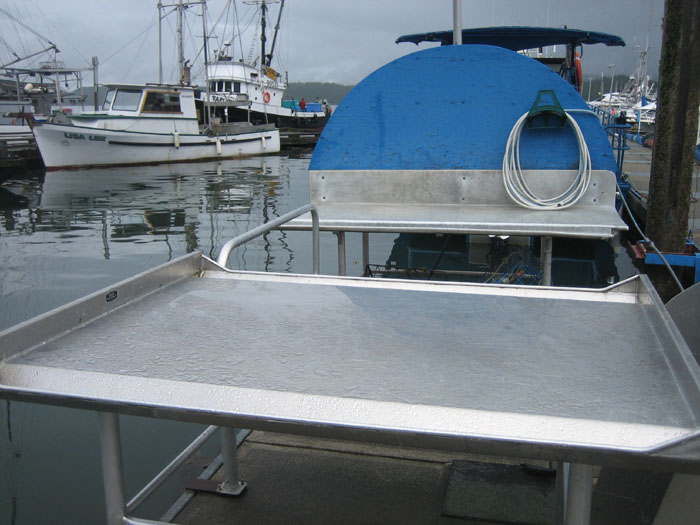 the fish just threw you up there like a big
slab of dead meat. It could be your mom or brother on the table
nearby too. First they start with mom, between swigs of cold beer
and a few belly laughs, they cut off her head with a swift sharp
chop and carelessly and nonchalantly throw it over the side. Then
they slit her down the center, from the neck to the bottom, pull out
her guts and throw them over the side with all the other decapitated
human heads of other relatives perhaps? They are thrown in along
with all the other guts and body parts from the day. These naïve
stupid fish would then proceed (between bouts of laughter at how
many of you they caught today, some boasting about how fat or big
you are, and who caught the biggest and oldest) to sliced us up into
meal size portions, packing arms and hands and buttocks, etc. in
plastic bags and then finally carting you and the rest of the family
off down the docks and up the ramp, all snuggly packed in coolers
and zip lock packages filled to the brim. These heartless uncaring
salmon hardly have the strength to push the huge load of human body
parts down the dock and up the ramp to the car as there is sooo
much, way more than they ever would need. Maybe your brothers and
sisters are in there too and an uncle and grandma too, dripping a
sad trail of blood, leaving a story that no one pays attention to,
the whole length of the dock. It’s a trail that is hosed off the
dock each day, no remembrance, no concern, no care.
the fish just threw you up there like a big
slab of dead meat. It could be your mom or brother on the table
nearby too. First they start with mom, between swigs of cold beer
and a few belly laughs, they cut off her head with a swift sharp
chop and carelessly and nonchalantly throw it over the side. Then
they slit her down the center, from the neck to the bottom, pull out
her guts and throw them over the side with all the other decapitated
human heads of other relatives perhaps? They are thrown in along
with all the other guts and body parts from the day. These naïve
stupid fish would then proceed (between bouts of laughter at how
many of you they caught today, some boasting about how fat or big
you are, and who caught the biggest and oldest) to sliced us up into
meal size portions, packing arms and hands and buttocks, etc. in
plastic bags and then finally carting you and the rest of the family
off down the docks and up the ramp, all snuggly packed in coolers
and zip lock packages filled to the brim. These heartless uncaring
salmon hardly have the strength to push the huge load of human body
parts down the dock and up the ramp to the car as there is sooo
much, way more than they ever would need. Maybe your brothers and
sisters are in there too and an uncle and grandma too, dripping a
sad trail of blood, leaving a story that no one pays attention to,
the whole length of the dock. It’s a trail that is hosed off the
dock each day, no remembrance, no concern, no care.
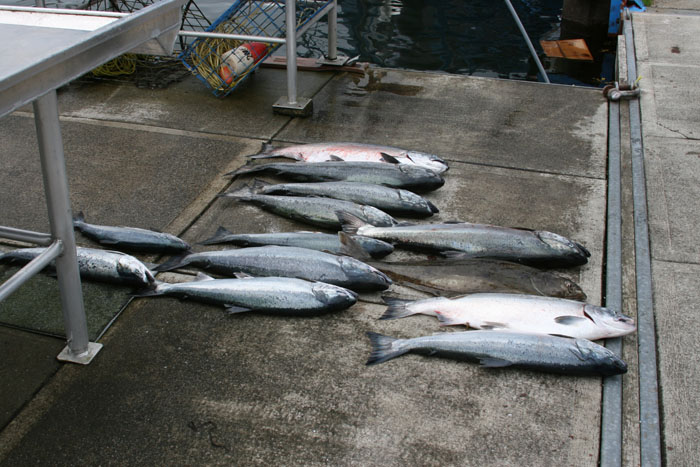







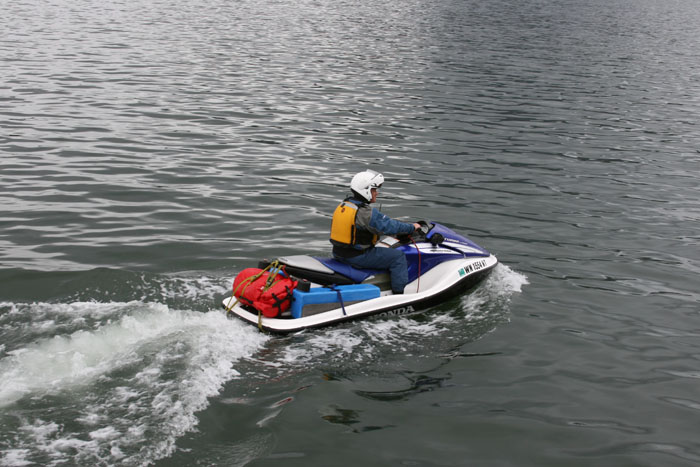 What the heck is someone up here on
the freezing cold water doing in a jet ski? I noticed that he’s got big
custom fuel tanks built in on each side of the jet ski and is clothed in a
somewhat state of the art looking severe weather suit and is sporting a
hard protective helmet. I was so curious about him, having a feeling that
he came a long way and had an interesting story to tell. I pleaded with
Larry, while I cleaned up the dishes, to go down the dock and find out
where he came from.
What the heck is someone up here on
the freezing cold water doing in a jet ski? I noticed that he’s got big
custom fuel tanks built in on each side of the jet ski and is clothed in a
somewhat state of the art looking severe weather suit and is sporting a
hard protective helmet. I was so curious about him, having a feeling that
he came a long way and had an interesting story to tell. I pleaded with
Larry, while I cleaned up the dishes, to go down the dock and find out
where he came from. 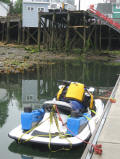


 We glanced over at the
ferry terminal and see an old vessel much like a big old tug boat that has
been converted into a traveling sports fishing lodge. We think that we’ve
seen it before somewhere in our travels in Alaska, in 2002. It has four
spiffy aluminum skiffs tied up to the back in a neat row. Again, it’s an
example of this big sports fishing craze going on up here. I guess there
are no fish other places and this is the last place.
We glanced over at the
ferry terminal and see an old vessel much like a big old tug boat that has
been converted into a traveling sports fishing lodge. We think that we’ve
seen it before somewhere in our travels in Alaska, in 2002. It has four
spiffy aluminum skiffs tied up to the back in a neat row. Again, it’s an
example of this big sports fishing craze going on up here. I guess there
are no fish other places and this is the last place. 
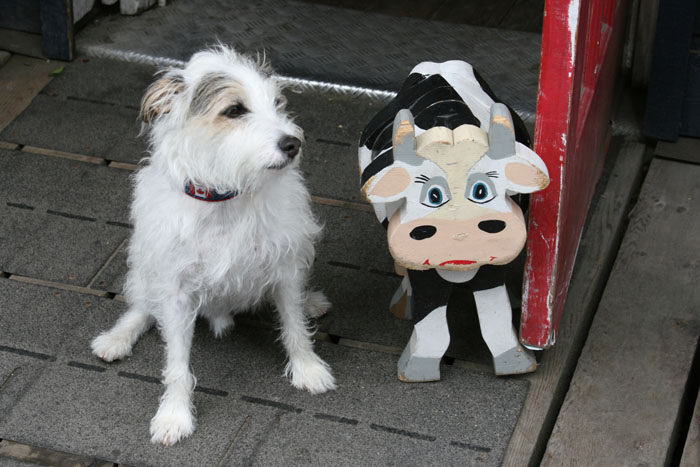
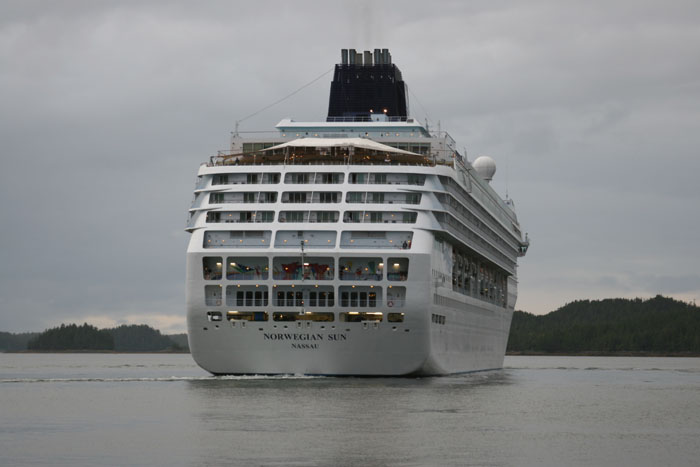
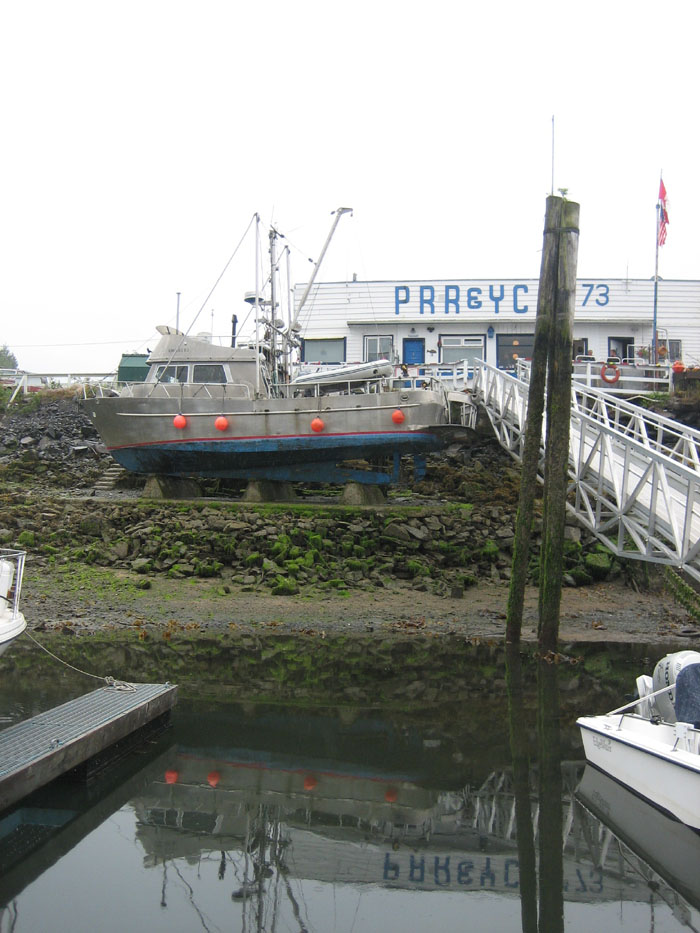 HUGE TIDE UP HERE
HUGE TIDE UP HERE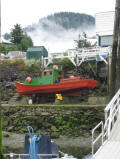

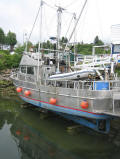
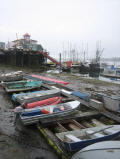
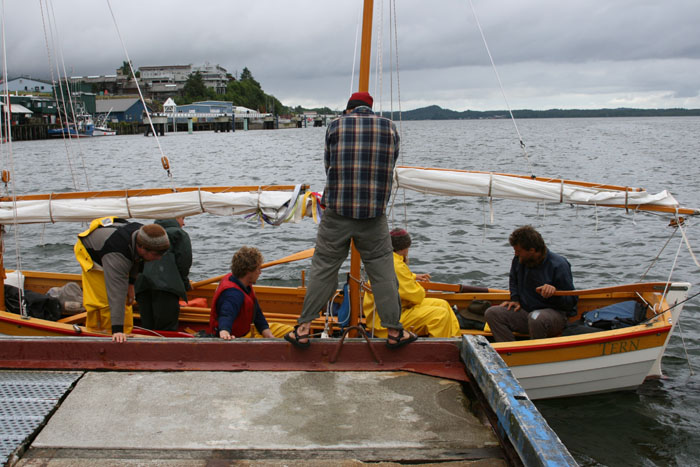
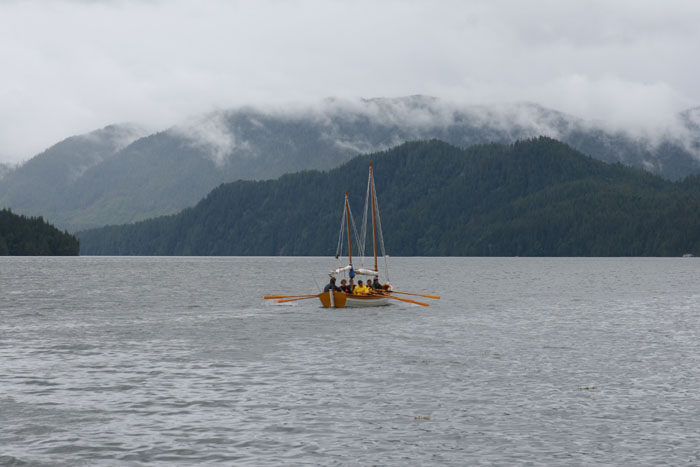 They were so tired and exhausted they
didn’t really have the energy or interest to chit chat with me at that
point but I was able to find out that they built their boat by hand in
Lopez Island, (of the San Juan Islands, near Anacortes Washington) and
that was their starting point. Check out the details on their website:
They were so tired and exhausted they
didn’t really have the energy or interest to chit chat with me at that
point but I was able to find out that they built their boat by hand in
Lopez Island, (of the San Juan Islands, near Anacortes Washington) and
that was their starting point. Check out the details on their website: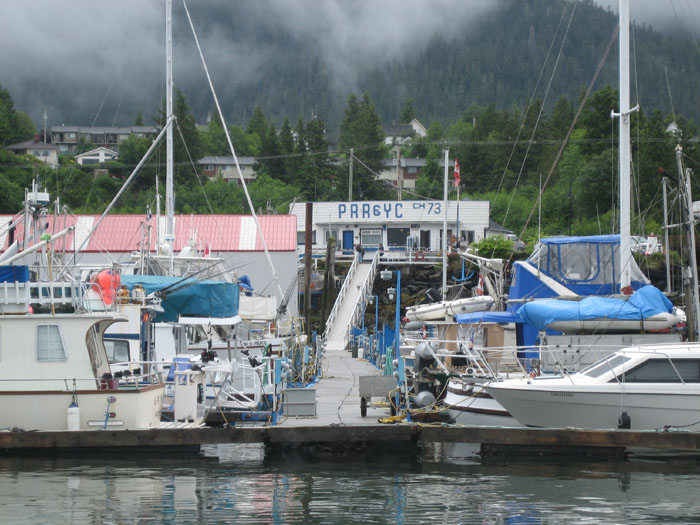 SPEAKING OF THE PRYC
SPEAKING OF THE PRYC















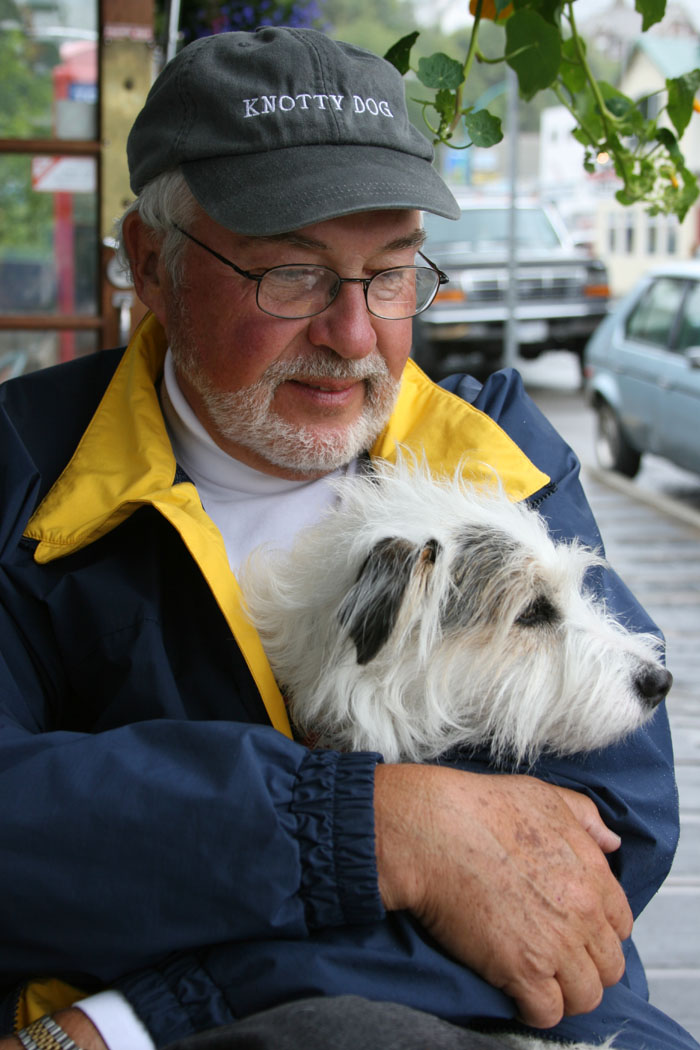 DREARY AND DEPRESSING
DREARY AND DEPRESSING

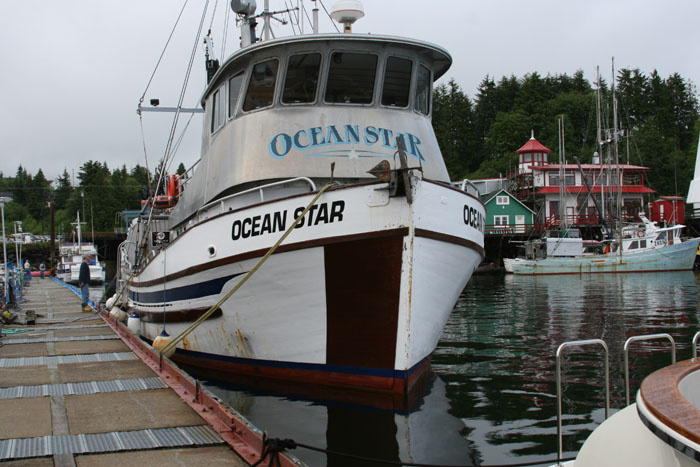 We talked
to the captain for awhile about his boat. He said he just couldn’t make a
living anymore fishing and decided to try this transportable fishing lodge
idea. He also was hoping somehow it would transfer into wildlife viewing,
kind of like and eco adventure. He was a nice guy and really, I thought
it would be a fun adventure to go on his boat for a week, to have the
experience of being on a real commercial fishing boat but have the
luxuries of a good meal and all that goes with it. I asked him if he goes
to Queen Charlottes to fish but he said not usually but could if the charterers requested it. I asked him about crossing Hecate Strait and
told him we were going to Queen Charlottes soon. He warned us that the
seas are dangerous and storms come up quickly and because the depths are
shallow it can be treacherous. He wanted to know what kind of boat we had
and when we pointed out Knotty Dog, he said “Is it just the two of you?”
I said, “Yes”. He said, “Well, monitor the two weather buoys as you make
the crossing and if anything changes, turn around and come back.
We talked
to the captain for awhile about his boat. He said he just couldn’t make a
living anymore fishing and decided to try this transportable fishing lodge
idea. He also was hoping somehow it would transfer into wildlife viewing,
kind of like and eco adventure. He was a nice guy and really, I thought
it would be a fun adventure to go on his boat for a week, to have the
experience of being on a real commercial fishing boat but have the
luxuries of a good meal and all that goes with it. I asked him if he goes
to Queen Charlottes to fish but he said not usually but could if the charterers requested it. I asked him about crossing Hecate Strait and
told him we were going to Queen Charlottes soon. He warned us that the
seas are dangerous and storms come up quickly and because the depths are
shallow it can be treacherous. He wanted to know what kind of boat we had
and when we pointed out Knotty Dog, he said “Is it just the two of you?”
I said, “Yes”. He said, “Well, monitor the two weather buoys as you make
the crossing and if anything changes, turn around and come back.
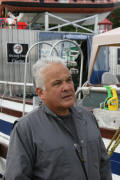
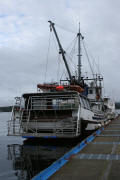
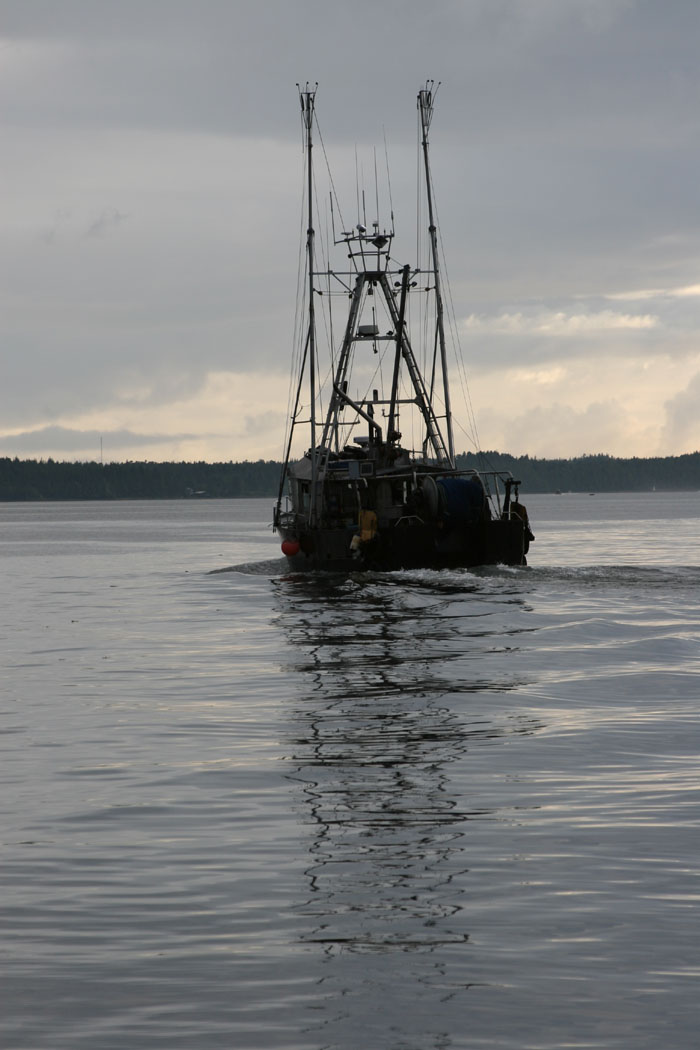 THE WEATHER IS RIGHT
THE WEATHER IS RIGHT




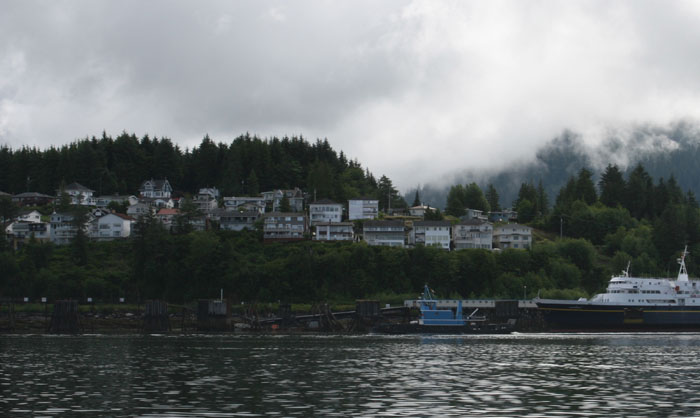






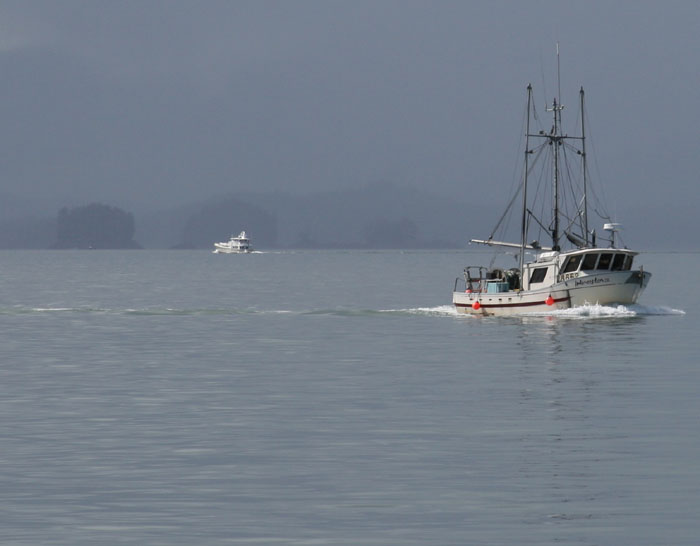





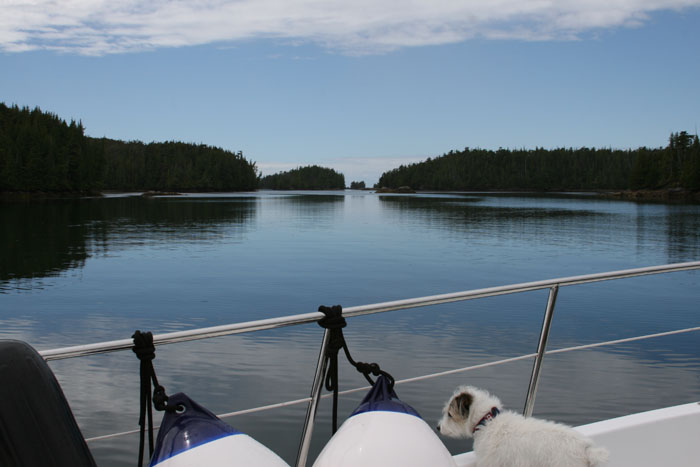 ALONE AT THE ANCHORAGE
EXCEPT FOR THE WHISPERS FROM THE FOREST
ALONE AT THE ANCHORAGE
EXCEPT FOR THE WHISPERS FROM THE FOREST